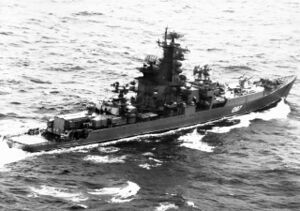Engineering:Kresta I-class cruiser
 Vitse-Admiral Drozd in 1986
| |
| Class overview | |
|---|---|
| Name: | Kresta I class |
| Builders: | Zhdanov Shipyard, Leningrad |
| Operators: | |
| Preceded by: | Kynda class |
| Succeeded by: | Kresta II class |
| Built: | 1964–1967 |
| In commission: | 1967–1994 |
| Planned: | 35 |
| Completed: | 4 |
| Cancelled: | 31 |
| Retired: | 4 |
| General characteristics | |
| Type: | Cruiser |
| Displacement: |
|
| Length: | 159 m (521 ft 8 in) |
| Beam: | 17 m (55 ft 9 in) |
| Draught: | 6 m (19 ft 8 in) |
| Propulsion: |
|
| Speed: | 34 knots (63 km/h; 39 mph) |
| Range: | 10,500 nautical miles (19,400 km; 12,100 mi) at 14 knots (26 km/h; 16 mph) |
| Complement: | 343-360 |
| Sensors and processing systems: |
|
| Armament: |
|
| Aircraft carried: | 1 × Ka-25 series helicopter |
| Aviation facilities: | Helipad and hangar |
The Kresta I class, Soviet designation Project 1134 Berkut (golden eagle), was a class of guided missile cruiser built in the Soviet Union for the Soviet Navy. The ships were designed for a surface warfare role, but Soviet priorities were changed to an anti-submarine role and only four ships were built in this configuration. They were followed by the Kresta II class, an anti-submarine warfare variant.
Design
Though considerably larger, more effective and reliable than the previous Soviet cruiser class, the Kynda class, the Kresta I surface warfare cruisers carried only half as many Shaddock launch tubes and one-fourth the total number of missiles. Initially it was planned to fit the SS-N-12 Sandbox (P-500 Bazalt) missile but the protracted development of this missile led to the older SS-N-3 being shipped. The self-defence armament was considerably increased as were command and communications facilities.
The Kresta Is could launch four SS-N-3b SLCMs and 44 SA-N-1 surface-to-air missiles with two twin launchers fore and aft, and had ten 533 mm (21 in) torpedo tubes. A single Ka-25 Hormone B helicopter was carried for targeting the cruise missile, and mid-course corrections.
Variants
- Project 934: Variant armed with eight short range anti ship missiles (SS-N-9) otherwise similar to the ships built. This design evolved into the Kresta II class.
- Project 934K: This was a larger flagship variant with enlarged command facilities and a bigger hangar for four or five helicopters. This variant was cancelled.
Ships
The initial plan was for a single squadron of seven ships armed with long range missiles and two squadrons of fourteen ships armed with shorter range missiles. Only four ships were built before production switched to the anti-submarine variant the Kresta II class.
All the ships were built by the Zhdanov Shipyard in Leningrad.
| Name | Russian | Laid down | Launched | Commissioned | Decommissioned |
|---|---|---|---|---|---|
| Admiral Zozulya | Адмирал Зозуля | 26 July 1964 | 17 October 1965 | 8 October 1967 | 15 December 1994 |
| Vladivostok | Владивосток | 24 December 1964 | 1 August 1966 | 1 August 1969 | 1 January 1991 |
| Vitse-Admiral Drozd | Вице-Адмирал Дрозд | 26 October 1965 | 18 November 1966 | 27 December 1968 | 1 July 1990 |
| Sevastopol | Севастополь | 8 June 1966 | 28 April 1967 | 25 September 1969 | 15 December 1989 |
See also
- List of ships of the Soviet Navy
- List of ships of Russia by project number
References
- Gardiner, Robert, ed (1995). Conway's All the World's Fighting Ships 1947–1995. London: Conway Maritime. ISBN 0-85177-605-1. OCLC 34284130. Also published as Conway's All the World's Fighting Ships 1947–1995. Annapolis, MD: Naval Institute Press. 1995. ISBN 1-55750-132-7. OCLC 34267261.
External links
- - Article in Russian
- - page from FAS in English
- (in English) All Russian Kresta I Class Cruisers - Complete Ship List
 |

